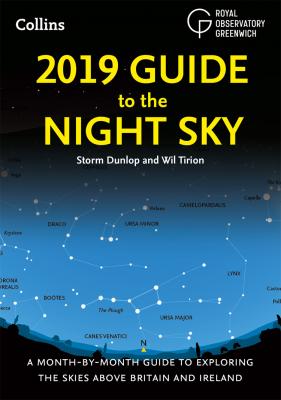ТОП просматриваемых книг сайта:
2019 Guide to the Night Sky: Bestselling month-by-month guide to exploring the skies above Britain and Ireland. Wil Tirion
Читать онлайн.Год выпуска 0
isbn 9780008311643
Автор произведения Wil Tirion
Жанр Справочная литература: прочее
Издательство HarperCollins
Published by Collins
An imprint of HarperCollins Publishers
Westerhill Road
Bishopbriggs
Glasgow G64 2QT
In association with
Royal Museums Greenwich, the group name for the National Maritime Museum,
Royal Observatory Greenwich, Queen’s House and Cutty Sark
© HarperCollins Publishers 2018
Text and illustrations © Storm Dunlop and Wil Tirion
Photographs © see acknowledgements here
Collins ® is a registered trademark of HarperCollins Publishers Ltd
All rights reserved under International and Pan-American Copyright Conventions. By payment of the required fees, you have been granted the non-exclusive, non-transferable right to access and read the text of this e-book on screen. No part of this text may be reproduced, transmitted, downloaded, decompiled, reverse engineered, or stored in or introduced into any information storage and retrieval system, in any form or by any means, whether electronic or mechanical, now known or hereafter invented, without the express written permission of HarperCollins.
The contents of this publication are believed correct at the time of printing. Nevertheless the publisher can accept no responsibility for errors or omissions, changes in the detail given or for any expense or loss thereby caused.
HarperCollins does not warrant that any website mentioned in this title will be provided uninterrupted, that any website will be error free, that defects will be corrected, or that the website or the server that makes it available are free of viruses or bugs. For full terms and conditions please refer to the site terms provided on the website.
A catalogue record for this book is available from the British Library
eBook Edition © Sep 2018
ISBN 9780008311643
Version: [2018-07-14]
Contents
The Northern Circumpolar Constellations
Introduction to the Month-by-Month Guide
The aim of this Guide is to help people find their way around the night sky, by showing how the stars that are visible change from month to month and by including details of various events that occur throughout the year. The objects and events described may be observed with the naked eye, or nothing more complicated than a pair of binoculars.
The conditions for observing naturally vary over the course of the year. During the summer, twilight may persist throughout the night and make it difficult to see the faintest stars. There are three recognized stages of twilight: civil twilight, when the Sun is less than 6° below the horizon; nautical twilight, when the Sun is between 6° and 12° below the horizon; and astronomical twilight, when the Sun is between 12° and 18° below the horizon. Full darkness occurs only when the Sun is more than 18° below the horizon. During nautical twilight, only the very brightest stars are visible. During astronomical twilight, the faintest stars visible to the naked eye may be seen directly overhead, but are lost at lower altitudes. As the diagram shows, during June and most of July full darkness never occurs at the latitude of London, and at Edinburgh nautical twilight persists throughout the whole night, so at that latitude only the very brightest stars are visible.
Another factor that affects the visibility of objects is the amount of moonlight in the sky. At Full Moon, it may be very difficult to see some of the fainter stars and objects, and even when the Moon is at a smaller phase it may seriously interfere with visibility if it is near the stars or planets in which you are interested. A full lunar calendar is given for each month and may be used to see when nights are likely to be darkest and best for observation.
The celestial sphere
All the objects in the sky (including the Sun, Moon and stars) appear to lie at some indeterminate distance on a large sphere, centred on the Earth. This celestial sphere has various reference points and features that are related to those of the Earth. If the Earth’s rotational axis is extended, for example, it points to the North and South Celestial Poles, which

